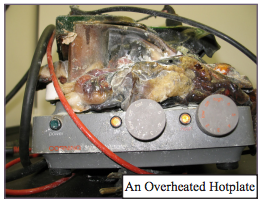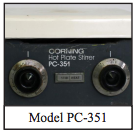Background
Spontaneous and unexpected heating of hotplates has been the cause of laboratory fires and explosions.
- In 2005, Lawrence Berkeley National Laboratory issued a safety advisory related to a Corning model PC 420 hot plate.
- In 2007, 2011, 2012, 2014 the University of California, University of Pennsylvania, MIT, and Oak Ridge National Lab issued similar safety advisories for Corning PC-35, PC-200, PC-220, PC- 351, Fisher IsoTemp and the Thermolyne Model:SP46925.
Issues
- Hotplates manufactured from 1960s – 1980s may still be in active use. Hotplates in disrepair may be in use.
- Older hotplates with relay heater switches can spontaneously heat in the heater dial OFF position.
- Liquids in contact with electronics may cause shorts. Newer hotplates with TRIAC or microprocessor-controlled heater switches may spontaneously heat in the OFF position due to liquid exposure to the electronics.
- Hotplate/stirrer combinations may be used when only stirring is required.
- Hotplate/stirrer combinations generally stay plugged in even when inactive.
- Temperature sensors may be misplaced, fall out or malfunction.
- Similarity of heating/stirring control dials and left /right reversal of control dials on hotplates from different manufacturers can lead to user errors.
- Users may not read user manuals.
Recommendations
- Discard old hotplates through Emory Surplus. Hotplates purchased prior to 1984 do not have temperature feedback controls. These models include the Corning PC-35 and PC-351 (pictured above) and the Thermolyne Model:SP46925.
- When only stirring is required, acquire and use a stirrer instead of a hotplate/stirrer combination.
- Unplug inactive hotplates or heating mantles in close proximity to oil baths, combustible or flammable material.
- Select hotplate housing designs that are less affected by spills and aggressive environments. Where liquid spills can be anticipated (i.e. water cooled reflux) do not use hotplates that have open housing designs.
- Look for hotplates with two independent temperature control circuits, which switch off heating in case of an over temperature situation.
- Make user manuals easily accessible.
References:
This article was adapted from the Northwestern University Office for Research Safety
Image Credits:


